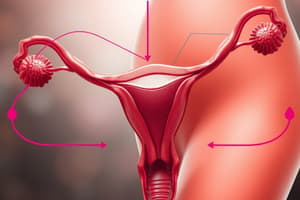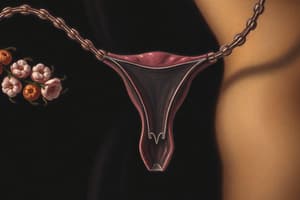Podcast
Questions and Answers
When is a woman considered safe to engage in sexual activity without the risk of pregnancy?
When is a woman considered safe to engage in sexual activity without the risk of pregnancy?
- Days 18-28 (correct)
- Days 6-8 (correct)
- Days 9-17
- Days 1-5
What is the average length of a menstrual cycle?
What is the average length of a menstrual cycle?
- 40 days
- 21 days
- 28 days (correct)
- 35 days
What is the maximum number of days a woman can menstruate during her period?
What is the maximum number of days a woman can menstruate during her period?
- 14 days
- 10 days
- 7 days (correct)
- 5 days
At what age do most girls experience their first menstrual cycle, referred to as menarche?
At what age do most girls experience their first menstrual cycle, referred to as menarche?
What characterizes days 9-17 in the menstrual cycle?
What characterizes days 9-17 in the menstrual cycle?
How is a menstrual cycle measured?
How is a menstrual cycle measured?
What is the term used for the first onset of the menstrual cycle?
What is the term used for the first onset of the menstrual cycle?
Which of the following ranges represents a normal menstrual cycle in days?
Which of the following ranges represents a normal menstrual cycle in days?
Which statement about menstrual cycles is true?
Which statement about menstrual cycles is true?
What is the primary effect of estrogen on the uterus during the menstrual cycle?
What is the primary effect of estrogen on the uterus during the menstrual cycle?
Which hormone works in conjunction with estrogen during the menstrual cycle?
Which hormone works in conjunction with estrogen during the menstrual cycle?
What happens to the corpus luteum after ovulation if pregnancy does not occur?
What happens to the corpus luteum after ovulation if pregnancy does not occur?
What indicates the peak level of estrogen during a normal menstrual cycle?
What indicates the peak level of estrogen during a normal menstrual cycle?
During which phase is the level of progesterone particularly low?
During which phase is the level of progesterone particularly low?
Which of the following hormones is primarily responsible for signals that stop FSH production?
Which of the following hormones is primarily responsible for signals that stop FSH production?
What physiological change does high estrogen levels signal during pregnancy?
What physiological change does high estrogen levels signal during pregnancy?
How is the life span of the corpus luteum regulated in relation to ovulation?
How is the life span of the corpus luteum regulated in relation to ovulation?
What physiological change occurs on the 14th day of the menstrual cycle regarding progesterone levels?
What physiological change occurs on the 14th day of the menstrual cycle regarding progesterone levels?
What triggers the release of LH during the menstrual cycle?
What triggers the release of LH during the menstrual cycle?
What is the primary role of LH during the menstrual cycle?
What is the primary role of LH during the menstrual cycle?
What structure forms from the Graafian follicle after ovulation?
What structure forms from the Graafian follicle after ovulation?
During which phase of the menstrual cycle are low progesterone levels present?
During which phase of the menstrual cycle are low progesterone levels present?
What is the primary purpose of sutures in the fetal skull?
What is the primary purpose of sutures in the fetal skull?
Which of the following correctly describes the anterior fontanel?
Which of the following correctly describes the anterior fontanel?
In fetal presentation, which position is characterized by the baby's buttocks entering the birth canal first?
In fetal presentation, which position is characterized by the baby's buttocks entering the birth canal first?
What relationship does fetal lie describe?
What relationship does fetal lie describe?
What potential risk is associated with a face presentation during labor?
What potential risk is associated with a face presentation during labor?
Which bones make up the main structure of the fetal skull?
Which bones make up the main structure of the fetal skull?
What is molding in the context of childbirth?
What is molding in the context of childbirth?
How long does it typically take for the posterior fontanel to close?
How long does it typically take for the posterior fontanel to close?
Which suture connects the two parietal bones of the fetal skull?
Which suture connects the two parietal bones of the fetal skull?
What is the correct term for a fetus positioned shoulder-first during childbirth?
What is the correct term for a fetus positioned shoulder-first during childbirth?
What is the primary function of the endometrium during implantation?
What is the primary function of the endometrium during implantation?
What condition occurs if implantation invades the myometrium?
What condition occurs if implantation invades the myometrium?
Which layer of the uterus is responsible for the uterine contractions during labor?
Which layer of the uterus is responsible for the uterine contractions during labor?
Which statement correctly describes the separation of the placenta after delivery?
Which statement correctly describes the separation of the placenta after delivery?
In the event of placenta accrete, what can potentially happen during delivery?
In the event of placenta accrete, what can potentially happen during delivery?
What is the role of the perimetrium in the uterus?
What is the role of the perimetrium in the uterus?
What defines the myometrium in terms of its structure?
What defines the myometrium in terms of its structure?
Which of the following statements about uterine layers is true?
Which of the following statements about uterine layers is true?
What can be a significant consequence of implantation occurring in the myometrium?
What can be a significant consequence of implantation occurring in the myometrium?
What is the primary function of Human Placental Lactogen (HPL) during pregnancy?
What is the primary function of Human Placental Lactogen (HPL) during pregnancy?
What is the significance of the Oral Glucose Tolerance Test (OGTT) during pregnancy?
What is the significance of the Oral Glucose Tolerance Test (OGTT) during pregnancy?
What type of decidua directly interacts with the implanted chorionic vesicles?
What type of decidua directly interacts with the implanted chorionic vesicles?
What is the purpose of Chorionic Villi Sampling (CVS) in pregnancy?
What is the purpose of Chorionic Villi Sampling (CVS) in pregnancy?
Which condition may arise from the effect of HPL during pregnancy on insulin?
Which condition may arise from the effect of HPL during pregnancy on insulin?
What is the role of the hypothalamus gland in the menstrual cycle?
What is the role of the hypothalamus gland in the menstrual cycle?
Which hormone is released by the anterior pituitary gland in response to GnRH?
Which hormone is released by the anterior pituitary gland in response to GnRH?
What observation indicates that a woman has a regular menstrual cycle?
What observation indicates that a woman has a regular menstrual cycle?
During which days are a woman considered to be in her fertile window based on a 38-day cycle?
During which days are a woman considered to be in her fertile window based on a 38-day cycle?
What marks the ovulation day in a 38-day cycle?
What marks the ovulation day in a 38-day cycle?
Which hormone is NOT classified as a type of GnRH?
Which hormone is NOT classified as a type of GnRH?
What are the safe days in a 38-day menstrual cycle?
What are the safe days in a 38-day menstrual cycle?
Which structure does the anterior pituitary gland stimulate?
Which structure does the anterior pituitary gland stimulate?
What indicates the start of the menstrual cycle?
What indicates the start of the menstrual cycle?
What could potentially occur in the case of an irregular menstrual cycle?
What could potentially occur in the case of an irregular menstrual cycle?
What is the average duration of a typical menstrual period?
What is the average duration of a typical menstrual period?
In a standard menstrual cycle, what does day 6-8 represent?
In a standard menstrual cycle, what does day 6-8 represent?
Which range of days in a menstrual cycle is associated with increased fertility risk?
Which range of days in a menstrual cycle is associated with increased fertility risk?
What is the minimum menstrual cycle length that is considered normal?
What is the minimum menstrual cycle length that is considered normal?
What term describes the first occurrence of a menstrual cycle?
What term describes the first occurrence of a menstrual cycle?
Which factor does NOT affect the regularity of menstrual cycles?
Which factor does NOT affect the regularity of menstrual cycles?
At what age does the average onset of the menstrual cycle occur?
At what age does the average onset of the menstrual cycle occur?
Which of the following statements best defines a menstrual cycle?
Which of the following statements best defines a menstrual cycle?
What occurs in the uterus when there is a decrease in estrogen and progesterone levels?
What occurs in the uterus when there is a decrease in estrogen and progesterone levels?
What change is observed in cervical mucus during the ovulation phase?
What change is observed in cervical mucus during the ovulation phase?
What happens to capillaries in the corpus luteum during its degeneration?
What happens to capillaries in the corpus luteum during its degeneration?
What does the term 'mittelschmerz' refer to?
What does the term 'mittelschmerz' refer to?
Which factor indicates the presence of 'RF' releasing factor?
Which factor indicates the presence of 'RF' releasing factor?
How does the status of the corpus luteum affect hormonal levels in the menstrual cycle?
How does the status of the corpus luteum affect hormonal levels in the menstrual cycle?
What is the primary function of the cervical mucus in relation to sperm?
What is the primary function of the cervical mucus in relation to sperm?
During the menstrual cycle, which structure is primarily responsible for hormone imbalance leading to menstruation?
During the menstrual cycle, which structure is primarily responsible for hormone imbalance leading to menstruation?
What symptom is commonly associated with the phase of ovulation?
What symptom is commonly associated with the phase of ovulation?
What best describes the role of the corpus luteum in the menstrual cycle?
What best describes the role of the corpus luteum in the menstrual cycle?
What occurs to the woman's basal body temperature during ovulation?
What occurs to the woman's basal body temperature during ovulation?
Which structure is primarily responsible for directing the ova towards the uterus?
Which structure is primarily responsible for directing the ova towards the uterus?
What is the lifespan of an ovum after it has been released from the ovary?
What is the lifespan of an ovum after it has been released from the ovary?
Which layer of the ovum is primarily composed of glycoproteins?
Which layer of the ovum is primarily composed of glycoproteins?
Where does fertilization most commonly occur within the female reproductive system?
Where does fertilization most commonly occur within the female reproductive system?
What is the primary characteristic of Androsperm?
What is the primary characteristic of Androsperm?
What is the expected duration for an ovum to reach the uterus after ovulation?
What is the expected duration for an ovum to reach the uterus after ovulation?
What structure forms during the journey of the ovum through the fallopian tube?
What structure forms during the journey of the ovum through the fallopian tube?
What is the primary reason for utilizing a basal body thermometer?
What is the primary reason for utilizing a basal body thermometer?
Which component of the ovum serves as the protective outer layer during development?
Which component of the ovum serves as the protective outer layer during development?
Flashcards are hidden until you start studying
Study Notes
Menstrual Cycle Overview
- Estrogen thickens the myometrium and endometrium, causing slight enlargement of the uterus.
- The corpus luteum has a lifespan of approximately two weeks.
- High estrogen levels are crucial if pregnancy occurs, as they support uterine enlargement.
- Estrogen and progesterone are not produced simultaneously; estrogen is associated with FSH, while progesterone is linked to LH.
Hormonal Dynamics
- Estrogen levels peak on day 13, while progesterone levels are low at that time.
- High estrogen signals the anterior pituitary gland (APG) to stop producing FSH.
- The corpus luteum, formed from the graafian follicle, produces progesterone, which prepares the uterus for potential implantation.
Uterine Functions
- The uterus has three main functions: site of implantation, nourishment of the fetus, and facilitation of labor.
- Implantation must occur in the endometrium; if it invades myometrium, it leads to complications such as placenta accrete.
- The uterus is made of three layers: perimetrium (outer), myometrium (middle), and endometrium (inner).
Fetal Skull Structure
- The fetal skull consists of three major bones: frontal, parietal, and occipital bones.
- Sutures are important cranial joints: frontal, coronal, sagittal, and lambdoidal sutures provide flexibility during birth.
- Fontanels include the anterior (diamond-shaped, closes in 12-18 months) and posterior (triangular, closes in 2-3 months) fontanels.
Fetal Presentation
- Presentations include cephalic (head first), breech (buttocks first), and transverse (shoulder first).
- Not all cephalic presentations lead to safe deliveries; facial presentations pose risks during contractions.
Fetal Lie
- Refers to the orientation of the fetus relative to the long axis of the uterus.
Menstrual Cycle vs. Menstrual Period
- Menstrual periods last 3-7 days, occurring within the larger context of a menstrual cycle, which averages 28 days but ranges from 23 to 35 days.
- Menarche marks the beginning of the menstrual cycle, typically occurring between ages 9-17, with an average age of 12.
Hormonal Cycle Specifics
- Days 1-5 are menstruating, days 6-17 are potentially fertile, and days 18-28 are generally safe for avoiding pregnancy.
- On day 13, estradiol levels peak leading to ovulation, while progesterone is low until post-ovulation when it rises sharply.
Key Hormonal Triggers
- The hypothalamus releases FSHRF to stimulate FSH production and LHRF for LH secretion from the APG.
- High levels of LH indicate ovulation; following this, progesterone supports the endometrium for potential implantation.
Menstrual Cycle and Safe Days
- Menstrual period refers to the days of menstruation, averaging three to five days, with a maximum of seven.
- Menstrual cycle starts from day one of the period to the day before the next period, typically averaging 28 days.
- Cycle lengths can range from 23 to 35 days, with a maximum of 40 days.
- Safe days for sexual activity:
- Day 1 to Day 5 (menstruation).
- Day 6 to Day 8 and Day 18 to Day 28.
- Fertile days, when pregnancy is possible, occur from Day 9 to Day 17.
Ovulation and Hormonal Changes
- Ovulation typically occurs about 14 days before the next menstrual cycle.
- Hormones involved:
- GnRH (Gonadotropic Releasing Hormone) released by the hypothalamus.
- FSH (Follicle Stimulating Hormone) and LH (Luteinizing Hormone) released by the anterior pituitary gland.
- Estrogen and progesterone levels increase post-ovulation, peaking during the luteal phase; decreased levels trigger menstruation.
Changes During Menstrual Cycle
- Signs of ovulation include:
- Drop in body temperature prior to ovulation followed by a rise.
- Changes in cervical mucus from dry to stretchy and clear, resembling egg white, facilitating sperm movement.
- Middle pain (mittelschmerz) can occur during ovulation, typically around day 14 of the cycle.
Reproductive Anatomy
- Gamete transport occurs in the fallopian tubes:
- Infundibulum (outer region).
- Ampulla (common fertilization site, also a site for ectopic pregnancy).
- Isthmus and interstitial (inner regions, also potential ectopic pregnancy sites).
- Ovum life span is approximately 24 hours after release from the ovary.
Structure of the Ovum
- Two significant layers surrounding the ovum:
- Corona Radiata: outer layer, formed from follicular cells.
- Zona Pellucida: thick, transparent layer composed of glycoproteins.
Pregnancy and Maternal Health
- hPL (Human Placental Lactogen) regulates glucose, protein, and fat levels during pregnancy, aiding fetal nutrition.
- OGTT (Oral Glucose Tolerance Test) is performed between the 24th and 28th weeks of pregnancy to screen for gestational diabetes.
- Decidua refers to the modified endometrial lining during pregnancy, with sections including:
- Decidua basalis: part of the placenta attachment.
- Decidua capsularis: surrounds the chorionic sac.
- Decidua vera: part of the cervical mucus plug.
Genetic Screening
- Chorionic Villi Sampling (CVS) collects placental tissue for genetic testing, performed earlier in pregnancy for risk assessment.
Studying That Suits You
Use AI to generate personalized quizzes and flashcards to suit your learning preferences.




